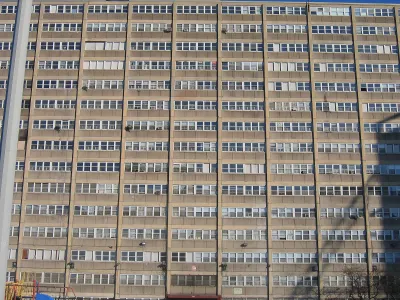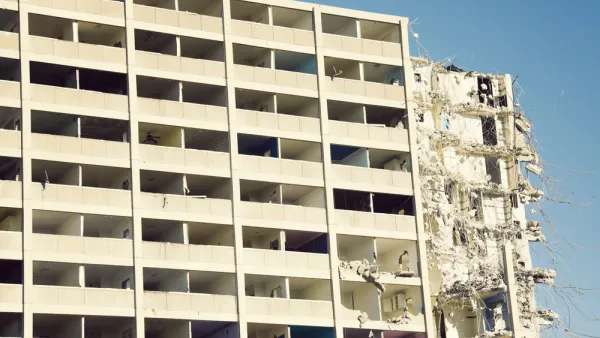The new film, set in one of America's most notorious public housing projects, highlights the failure of affordable housing policy and its impact on Black communities.

Like its 1992 predecessor, the Jordan Peele-produced Candyman places Cabrini-Green at the center of its story, making the real-life demise of the complex "the fundamental origin story of the film’s vengeful spirit." Brentin Mock describes the history and trauma that informs the film, which blends supernatural terror with extremely real horrors of neglected public housing projects and bad housing policy.
While the slasher in the film–"the apparition of a former Cabrini-Green resident who was killed by police in the 1970s"–is very real, writes Mock, gentrification is "the force that conjured it." Cabrini-Green's mostly Black residents "could live in few other neighborhoods in Chicago, due to racial covenants, job discrimination and lack of income." At the same time, "it was mostly Black people there who were first frozen out of their homes, due to the city’s withdrawal of services, and then driven out when the city decided Cabrini-Green had become too much of a blight" and had to be demolished. Today, the destruction of Cabrini-Green is "considered one of the largest losses of affordable housing stock in U.S. history."
This cruel paradox is explained with brevity in the film by Teyonah Parris's character, Brianna: "White people built the ghetto and then erased it when they realized they built the ghetto." Candyman, who shows up in mirrors when summoned, "is a reflection of destruction that white people have long visited upon Black people," says Mock, and the lingering problems that they are afraid to name.
FULL STORY: In Slasher Film ‘Candyman,’ the Horror Is U.S. Housing Policy

Analysis: Cybertruck Fatality Rate Far Exceeds That of Ford Pinto
The Tesla Cybertruck was recalled seven times last year.

National Parks Layoffs Will Cause Communities to Lose Billions
Thousands of essential park workers were laid off this week, just before the busy spring break season.

Retro-silient?: America’s First “Eco-burb,” The Woodlands Turns 50
A master-planned community north of Houston offers lessons on green infrastructure and resilient design, but falls short of its founder’s lofty affordability and walkability goals.

Test News Post 1
This is a summary

Analysis: Cybertruck Fatality Rate Far Exceeds That of Ford Pinto
The Tesla Cybertruck was recalled seven times last year.

Test News Headline 46
Test for the image on the front page.
Urban Design for Planners 1: Software Tools
This six-course series explores essential urban design concepts using open source software and equips planners with the tools they need to participate fully in the urban design process.
Planning for Universal Design
Learn the tools for implementing Universal Design in planning regulations.
EMC Planning Group, Inc.
Planetizen
Planetizen
Mpact (formerly Rail~Volution)
Great Falls Development Authority, Inc.
HUDs Office of Policy Development and Research
NYU Wagner Graduate School of Public Service



























